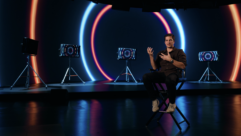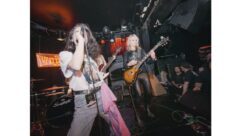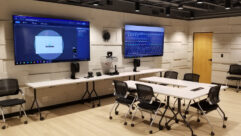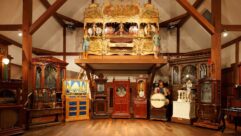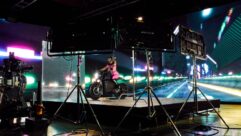A World of Reflections
Sep 1, 2002 12:00 PM,
Peter Mapp
Although people are surrounded by reflections, both visual and audible, they tend to ignore them. People are subconsciously aware of reflections, but that realization is generally suppressed. Awareness occurs because the reflection is somehow different or stands out because it arrives well after other arrivals or has been spectrally distorted. Walk into an anechoic chamber, and you immediately realize that something is missing from your normal aural environment — it is just as odd not to have reflections.
Psychoacoustically, you can characterize reflections by their time of arrival and direction as well as their spectrum. For example, early reflections — those that occur about 1 to 4 ms after a direct sound signal — can cause distinct coloration because of the strong comb-filtering interactions that occur (see Fig. 1). That generally subsides as the time interval increases and the strength of the reflection reduces from the associated increase in path length and resultant additional attenuation owing to spherical spreading of the sound wave (inverse square law).
From about 10 to 20 ms, reflections are generally not directly audible, but they integrate with the direct sound. However, they may affect the timbre and increase perceived loudness. At 20 ms, in a dry or low reverberation time environment, it is possible to detect the presence of a reflection. In practice, with most sound systems, that fusion or integration zone usually lasts as long as 30 to 35 ms, depending on the reverberation time of the space and the relationship to other sound arrivals. Trying to detect the presence of a single reflection in a laboratory is different from sitting in an auditorium or a concert hall in which the reverberation time will be typically between 1 and 2 seconds. At any location, a listener will hear literally thousands of reflections.
CAN YOU REPEAT THAT?
This same argument applies to the effect of reflections on speech intelligibility, a controversial topic. One school of thought, which is based on research carried out by many academic and practicing acousticians in the field of auditorium acoustics, suggests that sounds arriving within 50 ms will integrate and add to intelligibility. That integration time is sometimes reduced to 35 ms for smaller and less reverberant spaces.
Another theory holds that reflections do not add to intelligibility at all and, after 20 ms, are actually harmful rather than beneficial. The truth probably lies in the “it all depends” realm. If you are working in a reverberant environment of 1.8 seconds plus, then reflections arriving within 35 ms (and probably a slightly greater time window) will integrate with the direct sound and improve intelligibility. Under those circumstances, the listener receives multiple rather than discrete reflections. That observation is based not only on practical experience of working in such environments but also on the results of listening to jury speech-intelligibility experiments.
For example, I conducted a set of intelligibility experiments that employed a reverberation time of 2.3 seconds, and the intelligibility increased from an equivalent of 0.54 STI (9 %Alcons) to 0.70 STI (4 %Alcons) when the early reflected energy was increased. That was actually a slightly surprising result, as the object of this particular experiment was to show the reverse.
The effects of reflections have been investigated by many researchers. Haas is probably the most well-known, but he was just one of many, including Wallach, Newman, and Meyer and Shodder. The Haas effect curve shows the difference in level versus arrival delay for two signals to be judged as being equally loud. Meyer and Shodder’s experimental work on echo (reflection) shows perception as a function of level difference and arrival time.
The effect of a delay between signal arrivals and their disturbing effect can be seen in Fig. 2, which was taken from the work of Haas. This latter set of curves sheds some interesting light onto how people perceive reflections. For example, fewer than 10 percent of the listeners were disturbed by a strong (0 dB) reflection arriving at 40 ms, and a much lower percentage of the listeners still were disturbed when such a reflection was attenuated by 3 dB. The graph is of real practical value because it indicates by how much a troublesome reflection would need to be attenuated to reduce its disturbance. Although true only for single reflections, it nevertheless serves as a useful guide. In Fig. 3, a strong late reflection can clearly be seen, but how disturbing is it? In such cases, the reflection is not perceived as a discrete echo but more as a general “blurring” of the sound, which affects intelligibility but is difficult to define.
In practice, disturbing reflections are often caused by groups of reflections arriving within a narrow time frame rather than discrete individual echoes, though those also can occur. When a group of reflections is seen, that generally indicates some form of sound focusing or collection, such as from a curved surface or room corner (see Fig. 4). Here the cause was a dome that acted like a parabolic reflector and focused the sound back to a point.
Such reflections are generally highly colored, which adds also to their disturbing nature. An example of a discrete reflection problem is shown in Fig. 5, which indicates a strong late reflection that occurred in a large conference room. A group of discrete, late arrivals can clearly be seen, with the first appearing at about 90 ms after the direct sound and only 5 dB down. To say that it was disturbing would be somewhat of an understatement.
The problem was to find out where it and the slightly later arrivals originated from. An omnidirectional microphone is not much help here; it, by definition, does not provide any directional information. A directional mic can help, but it is surprising how “undirectional” directional microphones actually are when it comes to reflection tracking. A parabolic reflector microphone can be useful, though cumbersome. The best solution is to use a three- or four-point intensity probe and derive the reflection directions from the arrival time differences that occur at each of the individual mic capsules. However, that approach tends to be only for the academic research laboratory. An alternative is to use the TEF Polar ETC program and a directional microphone tripod and aiming system. That enables reflection strengths and directions to be accurately discovered.
In Fig. 5, the reflections were tracked down to the front of a broadcast commentary box. Whereas the timber front could be treated, the strongest reflection came from the observation window. That showed that unless the booth could be reconstructed to slant the glazing, there was no point in treating just the timber front.
DISTURBING REFLECTIONS
Reflections are often spectrally distorted, in that different frequencies may be selectively reflected or absorbed by the offending surface. For example, the discrete reflection occurring at 500 Hz in Fig. 6 is a strong reflection — considerably greater in strength than the direct sound. At 2,000 Hz, a different pattern can be seen. In many instances, the cause of a reflection can immediately be ascertained. The very late reflection shown in Fig. 7 came from the rear wall of a new concert hall and was a definite case of “I told you so.”
Had the recommended treatment been incorporated from the start, the problem would never have been seen (or, rather, heard). It took six months of wrangling with the architect to put back what should have been there in the first place, and it came at the expense of the architect’s design.
You do not need to be in a large room to experience a disturbing reflection or sequence of reflections. Fig. 8 shows a sequence of flutter echoes occurring in a small room as the sound zings between the walls. Such echoes can be highly colored and very noticeable when excited by a hand clap or another impulsive source. However, in practice, they can be excited only by a source located between two parallel walls or fairly large parallel hard surfaces (dependent on the wavelength involved). In an auditorium, that means often only the audience can cause the problem. Flutter echoes and comb-filtering reflections have been known about for a surprisingly long time.
Sound focusing and the whispering gallery effect have been known about for a long time, and physicist Young (of Young’s modulus and Young’s slits fame) gave the first scientific explanation of the phenomena (see Fig. 9).
KNOW THE BOUNDARIES
Another example of problematic reflections, and one that probably concerns most people, is that of boundary interference. That is particularly common with high-fidelity studio monitoring and home-cinema systems. All too often, in a domestic or even commercial situation, it is necessary (or at least desirable) to position loudspeakers directly against or close to room walls and boundaries. Interference can occur (in this case, it is encouraged to occur) between the direct sound radiating from the loudspeaker and a strong, fast reflection from the nearby wall or boundary.
The effects can be quite severe, as seen in Fig. 10, which shows what happens to the frequency response of a high-quality monitor loudspeaker when placed close to a room wall. The immaculately flat, ruler line frequency response has become more akin to a profile map of the Rocky Mountains than a loudspeaker response chart. But what can be done to overcome such a problem? The most effective solution also turns out to be the simplest, which is to move the loudspeaker away from the wall. The response cleans up beautifully just by moving the loudspeaker one meter away. If that is not possible, the first thing that is often thought of is to put some form of absorptive treatment on the offending wall. That, however, is rarely effective. Most commonly available materials — such as carpet, fuzz, or drapes — do not absorb well at low and lower mid frequencies.
Unless you want to go for a high-tech anechoic chamber look (meaning 2- to 3-foot wedges and not your puny, imitation waffle foam), then absorption is really not the way to go, though some specialist products might help. Try diffusion and turn the specular reflection disaster into a diffuse reflection scene of serenity. By diffusing the raw energy of the specular reflection (that is, the normal hard incidence reflection) into a scattered, slightly time-smeared release of energy, the propensity to cause a strong interference reaction is greatly reduced if not completely overcome. RPG makes a range of products and materials that can do the job in this type of situation.
An alternative to providing diffusion at the wall surface is to use a diffusing source loudspeaker. Until recently, that was not a reality, but distributed mode loudspeakers can have just that type of property. Fig. 11 shows what happens when a conventional loudspeaker and DML are placed close to a reflecting wall. The comb filtering clearly present with the conventional loudspeaker is hardly visible (or audible) with the DML, though as might be expected, that depends on the DML’s detailed design.
A reflectionless world would be a pretty boring place in which to live and a nightmare for a musician to play in. As with most things, you need reflections in moderation.
Peter Mapp is senior partner of AMS-Peter Mapp Acoustics, an acoustics consultancy based in the United Kingdom. Mapp is S&VC’s sound-reinforcement technical consultant. He can be reached at [email protected].


